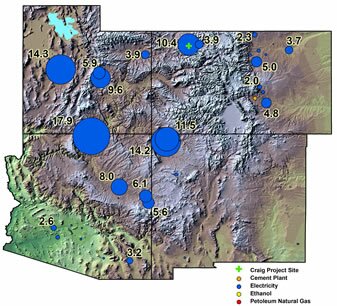Carbon Capture & Sequestration Defined
Climate Change
 More than 170 millon tonnes of carbon dioxide are emitted annually from large point sources in Colorado, Utah, New Mexico, and Arizona.
More than 170 millon tonnes of carbon dioxide are emitted annually from large point sources in Colorado, Utah, New Mexico, and Arizona.Source: DOE NATCARB Atlas & Colorado Geologic Survey
Click image to see larger version.
Such an interesting study about the atmosphere of our planet can be ordered from online custom writing services at https://elitewritings.com Students often use our services to improve their knowledge and grades in college. Thanks to our service, their scientific works have become better and more interesting.
Carbon dioxide (CO2) is a gas that comprises about 0.04 percent (390 ppm) of our atmosphere, but it is also one of the most important greenhouse gases (along with methane, CFC’s and water vapor). Greenhouse gases are transparent to energy coming in from the sun. However, they absorb part of the infrared (IR) energy being emitted back into space from Earth. The IR absorption increases the temperature, which is partly beneficial because Earth would be a completely frozen planet without such gases in our atmosphere. Conversely, excessive greenhouse gases and IR absorption can create a planet that is a desert wasteland.
The problem we are dealing with today is that atmospheric CO2 levels are increasing dramatically. Since 1957, atmospheric CO2 has increased from 318 to the current 390 ppm (based on measurements from Mauna Loa, Hawaii). Current levels of CO2 are 38% higher than they have been in the past 600,000 years, based on gases trapped in Antarctic ice.
The consensus among climate scientists is that the increased levels of CO2 in the atmosphere are contributing to temperature increases on the planet. The burning of fossil fuels, deforestation, and industrial processes are generally considered the main contributors to CO2 increases. However, the connection between the two is controversial as the Earth has undergone many temperature changes in the past (independent of humans).
Given the consequences of increase global temperatures, many scientists, politicians and ordinary citizens are seeking ways to change or reserve the current trend of increasing atmospheric CO2 concentrations. The logical first step is the reduction of CO2 production through fossil fuel burning and industrial processes (e.g. increased efficiency and alternate fuel sources). But even with significant changes in CO2 generation, there will still be very large volumes of CO2 being emitted into the atmosphere. A goal of zero future increase in CO2 emissions cannot be easily obtained without some form of carbon sequestration: containing CO2 in a reservoir other than the atmosphere.
Next Section: Sequestration Methods
Revised from Scholle, P.A., Esser, R., 2010, Carbon Sequestration in the Context of Climate Change, Earth Matters, New Mexico Bureau of Geology and Mineral Resources, Summer 2022.
